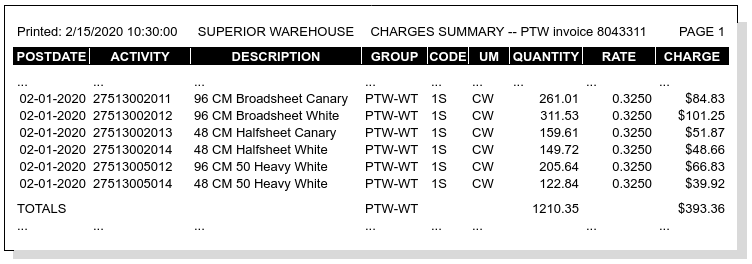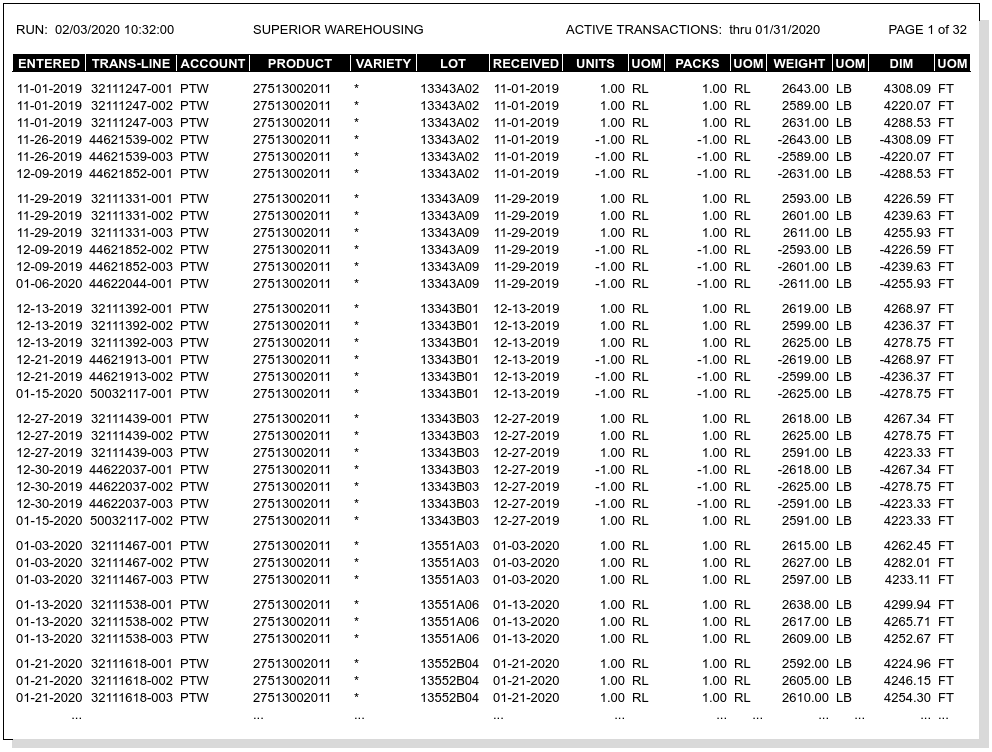Recurring Calculation Audits¶
Recurring Reports¶
Recurring calculations produce two audit trails. The Stock Activity Audits detail inventory stock movement during the recurring period, resulting in a quantity balance to be billed. The Recurring Charges Audits list charges billed for the quantity balance.
The customer should receive both reports with the recurring storage invoice, one report for inventory management and the other for accounting.
Note
Inventory may be tracked by unit, lot, or product, but the stock activity is reported by lot or product using the billing units of the storage charges. Then charges are summarized and reported by product only.
Recurring Charges Audits¶
Recurring charges are always audited with a version of the Charges Summary report, as shown following.

Note
Each row of this report lists charges for one product identifier/variety combination. The Activity column contains the product identifier; the Description shows the product description, not the charge description.
Stock Activity Audits¶
Billing quantities for stock activity and balances are captured with the Stock Activity Audit. This report is divided into two sections: identifying information for each item on the left, and quantitative data on the right.
Columns for the report identifier section are:
| Column Name | Description |
|---|---|
| AUDIT | (heading) Calculation Batch Number |
| RUN DATETIME | (heading) Date Time batch started |
| ACCOUNT | Customer Account Code |
| PRODUCT | Product Code Identifier |
| VARIETY | Variety Code, if used |
| LOT | When tracking lots, the Lot Number |
| RECEIVED | Inventory date Posted + freedays |
| UOM | Per code UOM (units, packages, ...) |
Audit and Run datetime apply to the entire report, and so these items appear in the report identifier section heading, as shown in the following sample Stock Activity report:

Activity Quantitative Data¶
The following table lists quantitative data from the right side of the activity report. Again, calendar range Last+1 and Next apply to the entire account and so these items appear in the data section heading. All data columns are listed below.
| Column Name | Description |
|---|---|
| RANGE LAST+1 | (heading) Calendar Last Date + 1 |
| RANGE NEXT | (heading) Calendar Next Date |
| STARTING DATE | Lot Anniversary Starting Date |
| ON HAND | Lot Balance on Starting Date |
| RECEIVED | Quantity Received during Period |
| SHIPPED | Quantity Shipped during Period |
| ADJUSTED | Quantity Adjusted during Period |
| BALANCE | Lot Balance at Period Ending Date |
| ENDING DATE | Lot Anniversary Ending Date |
For a lot to be included in a particular recurring calculation batch, the lot anniversary End Date must fall within the Range Last+1 to Next bracket of the calculation. An account’s recurring calendar determines lot anniversary Ending values for periodic recurring accounts; while the individual lot’s Received date is used for anniversary accounts.
Note
Since the Stock Activity Audit is a product report, the UOM code LB is taken from the product setup, which has units of measure for Units, Packages, Inners, Weights and Dimensions.
Compare this to the Charges Audit, which is a billing report. The rate provides billing UOM code CW and factor 100, which are required to convert from activity quantities in LB to billing quantities in CW.
Period Transaction Reporting¶
The Received, Shipped, and Adjusted columns of an Activity report are based on the inventory transactions posted in the period. A transaction detail report may be produced to audit the Activity Report, as shown following:

The preceding report images drill down from a recurring bill to the charges which constitute the invoice amount, to the audit of inventory lots and their activity, and to the individual transactions which determine lot balances.